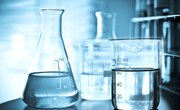
Just like following recipes for cooking delicious meals, successfully doing experiments requires paying attention to mixing chemicals in the right ways. Making solutions of a certain percent, such as 1%, is important when it comes to repeating the experiment and getting the same results.
What is BSA?
The word bovine means “cow,” and bovine serum albumin (BSA) is a protein that comes from cows. In particular, BSA is a type of protein called albumin, which is found in large amounts in the blood of cows. Blood is a mixture of red blood cells, which is why blood looks red, and many different types of proteins that are dissolved in water. If the cells in blood were removed, you would be left with a clear liquid, called serum. Thus, BSA is the albumin protein that is found in the blood of cows. In the blood, the job of albumin is to carry other proteins from place to place.
What is a 1% Solution?
The word “solution” describes something that exists as a liquid. For example, both water and milk are solutions. When we say that a solution of water is 1% sugar, it means that 1% of the molecules in that solution are sugar molecules, while the other 99% are water molecules. Thus, a 1% solution of BSA means that 1% of the molecules in that solution are BSA. Since BSA is often sold as a dry powder, a certain amount of it needs to be weighed out and then dissolved in a liquid, such as water. Dissolving BSA powder into a liquid is called a weight-by-volume dilution, often written as “w/v” in the instructions that accompany chemicals or scientific experiments.
Accurately Weighing Out Small Amounts of Powder
BSA powder is very light and is often used in small amounts, so researchers need a very sensitive weighing scale in order to accurately measure out BSA. Researchers often do not need large amounts of a BSA solution, so making several gallons or liters at once would be a waste of powder and storage space. Biochemistry and molecular biology experiments often use small amounts of BSA solution, and it is generally good practice to make it fresh each time. A simple way of making a 1% BSA solution is to weigh out one gram of BSA powder, pour it into a graduated cylinder that can hold more than 100 milliliters (mL) of water, and then add water until the liquid level reaches the 100 mL mark. Mathematically, one divided by 100 equals 1%.
Picking the Right Solvent to Dissolve BSA Powder
Not all experiments require that BSA be dissolved in water, since pure water has different properties than the liquid that flows in the blood stream of animals and that surrounds the outside of cells. The liquid inside of animals has certain amounts of salts and acids, so if the purpose of the BSA solution is carrying a drug that will be injected into live animals, the BSA powder should be dissolved in a special liquid. A common liquid used for experimental purposes is phosphate buffer saline (PBS). PBS has properties similar to those of the liquid inside living organisms such as mice, dogs and humans, so it can be used to dissolve BSA and whatever chemical BSA is shuttling around.
References
About the Author
David H. Nguyen holds a PhD and is a cancer biologist and science writer. His specialty is tumor biology. He also has a strong interest in the deep intersections between social injustice and cancer health disparities, which particularly affect ethnic minorities and enslaved peoples. He is author of the Kindle eBook "Tips of Surviving Graduate & Professional School."
Photo Credits
Medioimages/Photodisc/Photodisc/Getty Images
